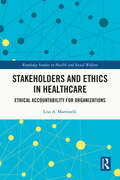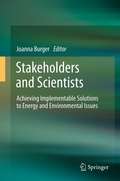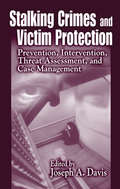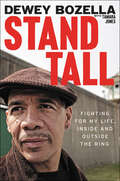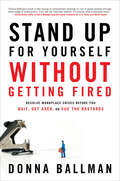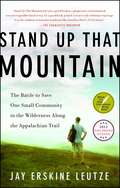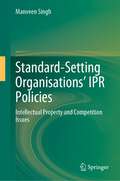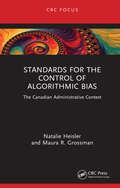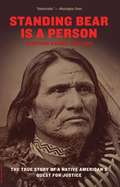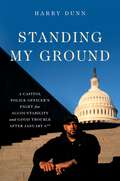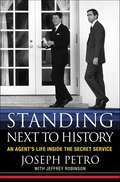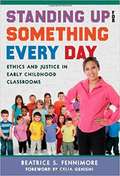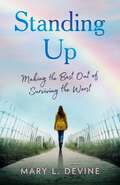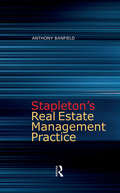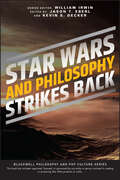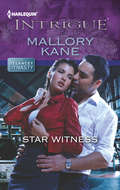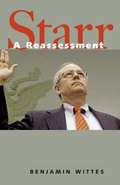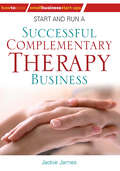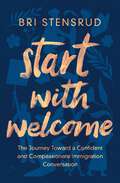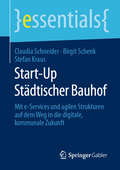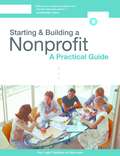- Table View
- List View
Stakeholders and Ethics in Healthcare: Ethical Accountability for Organizations (Routledge Studies in Health and Social Welfare)
by Lisa A. MartinelliThis ground-breaking book uses organizational ethics and stakeholder theory to explore the ethical accountability of leadership in healthcare organizations to their distinct vulnerable stakeholder communities. The book begins with a discussion of the moral agency of healthcare organizations and introduces stakeholder theory. It then looks at key ethical challenges in relation to the confidentiality and privacy of health care data, before turning to child health and interventions around issues such as obesity, maltreatment, and parenting. The book ends by focusing on ethics of care in relation to older people and people with disabilities. An insightful contribution to thinking about ethics for contemporary healthcare management and leadership, this interdisciplinary book is of interest to readers with a background in healthcare, business and management, law, bioethics, and theology.
Stakeholders and Scientists
by Joanna BurgerNation and the World must move forward with development of a range of energy sources and savings, all with attendant environmental problems. Solving these problems, and those remaining from past energy-related activities, will require iteration, inclusion, and collaboration with a wide range of stakeholders, including U.S., State and local governmental agencies, Tribal Nations, scientists, environmentalists, public policy makers, and the general public.
Stalking Crimes and Victim Protection: Prevention, Intervention, Threat Assessment, and Case Management
by Joseph A. DavisAlthough stalking is an age-old phenomenon, it is only recently receiving due attention. In a span of just ten years, all fifty states have passed anti-stalking legislation. For the first time, Stalking Crimes and Victim Protection: Prevention, Intervention, Threat Assessment, and Case Management brings together in one source all the research done
Stalking the Subject: Modernism and the Animal
by Carrie RohmanHuman and animal subjectivity converge in a historically unprecedented way within modernism, as evolutionary theory, imperialism, antirationalism, and psychoanalysis all grapple with the place of the human in relation to the animal. Drawing on the thought of Jacques Derrida and Georges Bataille, Carrie Rohman outlines the complex philosophical and ethical stakes involved in theorizing the animal in humanism, including the difficulty in determining an ontological place for the animal, the question of animal consciousness and language, and the paradoxical status of the human as both a primate body and a "human" mind abstracting itself from the physical and material world. Rohman then turns to the work of Joseph Conrad, D. H. Lawrence, H. G. Wells, and Djuna Barnes, authors who were deeply invested in the relationship between animality and identity. The Island of Dr. Moreau embodies a Darwinian nightmare of the evolutionary continuum; The Croquet Player thematizes the dialectic between evolutionary theory and psychoanalysis; and Women in Love, St. Mawr, and Nightwood all refuse to project animality onto others, inverting the traditional humanist position by valuing animal consciousness. A novel treatment of the animal in literature, Stalking the Subject provides vital perspective on modernism's most compelling intellectual and philosophical issues.
Stand Tall: Fighting for My Life, Inside and Outside the Ring
by Tamara Jones Dewey BozellaThe inspiring story of one man’s fight against his wrongful incarceration and his eventual triumph—both inside and outside the boxing ring.In the late 1970s, Dewey Bozella was wrongfully convicted of murdering Emma Crapser, a ninety-two-year-old resident of Poughkeepsie, New York. Sentenced to twenty years to life in prison, Bozella fiercely maintained his innocence throughout his ordeal at Sing Sing Correctional Facility, and even refused the prosecutor’s offer of freedom in exchange for an admission of guilt. But in 2009, more than a quarter century later, Dewey Bozella would reclaim his identity and his humanity when his conviction was vacated.In this raw and uplifting memoir, Bozella takes us through the trials, tribulations, and joys of his life inside prison and, eventually, as a free man. While at Sing Sing, he took up boxing to channel his anger, and eventually became the prison’s light-heavyweight champion. Bozella also met and married the love of his life from behind bars, lost countless parole hearings, and spent agonizing time on a cell block with both his brother’s murderer and, it turned out, the true crim-inal in whose place Bozella served so much time. But Bozella never gave up. After he was refused parole and had his sentence extended, the Innocence Project caught word of his case. Thanks to his undying faith, stalwart persistence, and the aid of a young pro bono attorney at the Innocence Project who doggedly worked toward Bozella’s release when all hope seemed lost, he was released from prison in 2009. Shortly thereafter, he won his professional boxing debut against Larry Hopkins, started an afterschool athletics program for at-risk youth, and was awarded the Arthur Ashe Award for Courage.An incredibly uplifting underdog story, Stand Tall recounts one man’s perseverance in the face of injustice and his difficult road to freedom.
Stand Up For Yourself Without Getting Fired: Resolve Workplace Crises Before You Quit, Get Axed, or Sue the Bastards
by Donna BallmanTake a deep breath and learn how to deal with a bad work situation: “Like having an employment attorney on call. . . . It’s exactly what employees need.” —Alison Green, author of Ask A ManagerUSA Best Book Award WinnerHate your job? Ready to quit? Facing a layoff before you even have a chance to quit? Is your boss is a flaming jerk? Think you might have a lawsuit? If any of these scenarios apply to you, you are facing a crucial career moment—and mistakes and misinformation will cost you dearly.In Stand Up for Yourself Without Getting Fired, celebrated attorney Donna Ballman provides winning answers to these and many more tough questions, such as:I think they’re getting ready to lay me off. What can I do?My boss is creating a hostile environment. Can I sue?What does it mean if I sign a paper saying I’m an independent contractor and not an employee?Am I exempt from overtime?Whether you’re a recent college grad or an almost-retiree, newly employed or laid off after twenty years; gay or straight; single or married with kids; janitor or CEO . . . Stand Up for Yourself Without Getting Fired will give you the specific and relevant advice you need to face any career-threatening situation . . . and come out ahead.
Stand Up That Mountain
by Jay Erskine LeutzeIn the tradition of A Civil Ac tion--the true story of a North Carolina outdoorsman who teams up with his Appalachian "mountain people" neighbors to save treasured land from being destroyed Living alone in his wooded mountain retreat, Jay Leutze gets a call from a whip-smart fourteen-year-old, Ashley Cook, and her aunt, Ollie Cox, who say a mining company is intent on tearing down Belview Mountain, the towering peak above their house. Ashley and her family, who live in a little spot known locally as Dog Town, are "mountain people," with a way of life and speech unique to their home high in the Appalachians. They suspect the mining company is violating the law, and they want Jay, a nonpracticing attorney, to stop the destruction of the mountain. Jay, a devoted naturalist and fisherman, quickly decides to join their cause. So begins the epic quest of the "Dog Town Bunch," a battle that involves fiery public hearings, clandestine surveillance of the mine operator's activities, ferocious pressure on public officials, and high-stakes legal brinksmanship in the North Carolina court system. Jay helps assemble a talented group of environmental lawyers to do battle with the well-funded attorneys protecting the mining company's plan to dynamite Belview Mountain, which happens to sit next to the famous Appalachian Trail, the 2,184-mile national park that stretches from Maine to Georgia. As the mining company continues to level the forest and erect a gigantic rock-crushing plant on the site, Jay's group searches frantically for a way to stop an act of environmental desecration that will destroy a fragile wild place and mar the Appalachian Trail forever. Much more than the record of a legal battle, Stand Up That Mountain takes the reader to a remote corner of Appalachia, a region often stereotyped and little understood, even now in the twenty-first century. A naturally elegant writer, Jay Leutze delivers a powerful, beautifully written story full of remarkable characters, such as "Wingfoot," an elusive protector of the Appalachian Trail; a stubborn mining company engineer intent on pulling down the mountain in the face of intense opposition; and Ron Howell, a retired and legendary North Carolina Superior Court judge known as the "Heel Hound" for his relentless pursuit of legal victory. Jay's plaintiff group is eventually joined by several national conservation groups who see that Belview Mountain and the Appalachian Trail must be protected for future generations of Americans. A great contemporary story that demonstrates what is possible when local people set their minds to righting a local wrong, Stand Up That Mountain will appeal to conservationists, hikers, attorneys, and readers fascinated by Appalachia and rural life, and anyone interested in a compelling story both well told and true.
Stand Up to the IRS
by Frederick W. Daily AttorneyIRS Bills? Get the information and strategies you need to deal with the taxman. Named a "Best Tax Book" by Entrepreneur.com The Internal Revenue Service is the taxpayer's worst nightmare, and for good reason -- a tax bill or other notice can come out of nowhere and wreak havoc on your life. But now you can confront America's most intimidating government agency with confidence. Stand Up to the IRS reveals the tactics used by IRS and how to deal with them. This book even contains confidential forms used by IRS agents during collection interviews and audits. Use Stand Up to the IRS to: file a late return work out a long-term payment plan get a Taxpayer Assistance Order settle your tax bill for pennies on the dollar stop collection efforts avoid property seizures protect your assets determine if bankruptcy offers a solution learn what to say when you face an auditor appeal the auditor's decision This edition is completely updated with the latest rules, regulations and tax numbers. Plus, Stand Up to the IRS also shows you how to go to Tax Court, if it's ever needed.
Stand Up to the IRS (10th edition)
by Frederick W. DailyDaily, an attorney with 30 years of experience in tax law, reveals tactics of the Internal Revenue Service and tells how to deal with them. He explains procedures for filing a late tax return, working out a long-term tax payment plan, getting a Taxpayer Assistance Order, protecting assets, and avoiding property seizures. He provides forms used by IRS agents during collection interviews and audits, and provides information and forms for Tax Court so that readers can represent themselves in cases involving less that $50,000. Annotation ©2004 Book News, Inc., Portland, OR (booknews.com)
Stand Your Ground: A History of America's Love Affair with Lethal Self-Defense
by Caroline LightA history of America’s Stand Your Ground gun laws, from Reconstruction to Trayvon MartinAfter a young, white gunman killed twenty-six people at Sandy Hook Elementary School in Newtown, Connecticut, in December 2012, conservative legislators lamented that the tragedy could have been avoided if the schoolteachers had been armed and the classrooms equipped with guns. Similar claims were repeated in the aftermath of other recent shootings—after nine were killed in a church in Charleston, South Carolina, and in the aftermath of the massacre in the Pulse nightclub in Orlando, Florida. Despite inevitable questions about gun control, there is a sharp increase in firearm sales in the wake of every mass shooting.Yet, this kind of DIY-security activism predates the contemporary gun rights movement—and even the stand-your-ground self-defense laws adopted in thirty-three states, or the thirteen million civilians currently licensed to carry concealed firearms. As scholar Caroline Light proves, support for “good guys with guns” relies on the entrenched belief that certain “bad guys with guns” threaten us all.Stand Your Ground explores the development of the American right to self-defense and reveals how the original “duty to retreat” from threat was transformed into a selective right to kill. In her rigorous genealogy, Light traces white America’s attachment to racialized, lethal self-defense by unearthing its complex legal and social histories—from the original “castle laws” of the 1600s, which gave white men the right to protect their homes, to the brutal lynching of “criminal” Black bodies during the Jim Crow era and the radicalization of the NRA as it transitioned from a sporting organization to one of our country’s most powerful lobbying forces.In this convincing treatise on the United States’ unprecedented ascension as the world’s foremost stand-your-ground nation, Light exposes a history hidden in plain sight, showing how violent self-defense has been legalized for the most privileged and used as a weapon against the most vulnerable.
Standard-Setting Organisations’ IPR Policies: Intellectual Property and Competition Issues
by Manveen SinghThis book offers a unique insight into the world of standard-setting organizations (SSOs)’ IPR policies and the role they play in balancing the interests of innovators and implementers, vis-à-vis the development of standards. Since the beginning of the 21st century, there have been quite a few questions asked of the SSOs as to the legality of their IPR policies and the enforceability of disclosure and licensing obligations enshrined therein. That, coupled with disagreements over the appropriate royalty rate and royalty base, has resulted in extensive litigation between innovators and implementers, especially across the Atlantic. The Book, in keeping the USA and EU as the two primary jurisdictions, offers a comprehensive analysis of the disclosure and licensing obligations under SSO IPR policies, with strong theoretical foundations justifying their imposition. More specifically, it offers a bird’s eye view of the various facets of disclosure and licensing, ranging from non-disclosure and transparency on one hand, to the determination of FRAND on the other. While much has been said about the benefits arising out of collaborative standard-setting, disputes involving SEP licensing have not been limited to the courts, and have attracted a significant amount of scrutiny by competition/antitrust agencies. The Book provides an elaborate account of the anti-competitive concerns surrounding standard-setting, and further documents the role of courts and competition agencies in ensuring good faith licensing negotiations between the SEP holders and implementers. Despite largely focusing on SEP licensing disputes in the USA and EU, the Book also offers a dedicated chapter on standard-setting in the Indian context. The readers are presented with an in-depth discussion on the contrasting approaches adopted by the courts and the Competition Commission of India (CCI), in addressing disputes involving SEPs. The said discussion is supplemented by a careful analysis of the SEP licensing guidelines to have emerged out of other implementer-oriented economies like China and Japan. By doing so, the Book offers readers the opportunity to study and compare the SEP licensing framework in developed, as well as developing economies. SSO IPR policies play an integral role in the development of standards, and with technologies such as the Internet of Things and 5G knocking on the doors, the Book makes for a valuable study on the nuances of standard-setting through the lens of SSOs, and will find takers among a wide reader base of students, researchers, academics, law practitioners, corporates, and policy makers.
Standards for the Control of Algorithmic Bias: The Canadian Administrative Context
by Natalie Heisler Maura R. GrossmanGovernments around the world use machine learning in automated decision-making systems for a broad range of functions. However, algorithmic bias in machine learning can result in automated decisions that produce disparate impact and may compromise Charter guarantees of substantive equality. This book seeks to answer the question: what standards should be applied to machine learning to mitigate disparate impact in government use of automated decision-making? The regulatory landscape for automated decision-making, in Canada and across the world, is far from settled. Legislative and policy models are emerging, and the role of standards is evolving to support regulatory objectives. While acknowledging the contributions of leading standards development organizations, the authors argue that the rationale for standards must come from the law and that implementing such standards would help to reduce future complaints by, and would proactively enable human rights protections for, those subject to automated decision-making. The book presents a proposed standards framework for automated decision-making and provides recommendations for its implementation in the context of the government of Canada’s Directive on Automated Decision-Making. As such, this book can assist public agencies around the world in developing and deploying automated decision-making systems equitably as well as being of interest to businesses that utilize automated decision-making processes.
Standing Bear is a Person: The True Story of a Native American's Quest for Justice
by Stephen Dando-CollinsThe only book about the landmark trial of the first Native American to be recognized legally as a person-an eloquent reminder of a fight well fought. -"Kirkus"
Standing My Ground: A Capitol Police Officer's Fight for Accountability and Good Trouble After January 6th
by Harry DunnNew York Times Bestseller The stirring memoir of Harry Dunn, a Capitol Police Officer on duty January 6th, who has become one of the most prominent and essential voices regarding the truth of that day, and &“a must-read for those care about our nation&’s future&” (Congressman Eric Swalwell). Walking the halls of democracy as a Capitol Police officer, Harry Dunn was a man slowly experiencing an awakening. It sparked after the election of our first Black president. It grew as his belief in the bravery and honor of law enforcement was shaken by Ferguson and countless other cases of police brutality towards the Black community. It continued to burn brighter as he watched members of Congress, many of whom he had befriended, lose their way to partisanship, as political extremism intensified. And it exploded into a blaze when he fought side by side with his fellow officers on January 6th, when democracy and their lives were threatened.Standing My Ground is &“a powerful, patriotic tale – told with striking moral clarity&” (Congresswoman Nancy Pelosi) that provides a crucial, definitive firsthand account of what happened on that day our country was shocked to its core. But it will also share the story of a man who refused to stay quiet when he learned that some of the men and women he had risked his life protecting, who knew him by name, would deny the horrors they faced. That&’s when he chose to speak up and to seek out what his hero John Lewis once termed &“good trouble.&” Dunn&’s ongoing story as a witness willing to meaningfully engage with the media, lawmakers, and the public provides a backdrop for examining the political and racial divide in this country—one that we must overcome in order to demand accountability and preserve our precious democracy.
Standing Next to History: An Agent's Life Inside the Secret Service
by Jeffrey Robinson Joseph PetroA former Secret Service agent revisits his twenty-three-year career, including his time as Ronald Reagan’s bodyguard, in this “engaging” memoir (Publishers Weekly).Joseph Petro served for twenty-three years as a special agent in the United States Secret Service, eleven of them at the White House and four of those as the man on the shoulder of Ronald Reagan.From his days as an investigator in the field, to his time as the man on whom the life of the president depended, Petro’s journey through history is a singular look inside the most discreet law enforcement agency in the world; an unparalleled insight into Ronald and Nancy Reagan; plus an up-close-and-personal view of the late Pope John Paul II, whom Petro protected during his historic and extraordinary ten-day tour of the United States in 1987.The cast of characters in these never-before-told stories ranges from the Reagans and the Pope, to Frank Sinatra, Bob Hope, Mikhail Gorbachev, Fidel Castro, Margaret Thatcher, François Mitterrand, the Shah of Iran, George H. W. Bush, Dan and Marilyn Quayle, Henry Kissinger, Nelson Rockefeller, Gerald Ford, and would-be assassins.“A close-in view of how ‘the Great Communicator’ charmed critics and won loyal followers.” —The Christian Science Monitor“A fascinating portrait of Secret Service life.” —Library Journal
Standing Up for Something Every Day: Ethics and Justice In Early Childhood Classrooms (Early Childhood Education)
by Beatrice S. Fennimore Sharon RyanStanding Up for Something Every Day is written for present and future teachers in the early childhood classroom who truly want to make a difference in the lives of children. Exploring some of the most complex and pressing social and ethical dilemmas confronting early childhood educators, the author provides concrete ways of addressing social justice concerns in practice. Four model teacher-guides accompany readers from chapter to chapter, and demonstrate strategies for standing up for children through ethics, respect for diversity, and commitment to advocacy. This book offers important insights, encouragement, and practical suggestions to early childhood educators who are committed to excellence and equity in their classrooms.
Standing Up: Making the Best Out of Surviving the Worst
by Mary L. DevineFor true-crime fans, a gripping memoir of a domestic violence survivor who becomes a police detective in the domestic violence unit and is forced to face her demons when her first major case mirrors her own violent assault.Standing Up invites you on an exhilarating journey with a woman who refuses to be defined by her scars. A pulse-pounding chronicle of survival against all odds, this memoir takes readers along on a plunge into the chilling depths of abusive relationships. At the tender age of twenty-three, Mary Sweeney-Devine unwittingly stumbled into the clutches of her abuser, igniting anguish and despair. With each heart-wrenching trial, including a hospital visit, she unearthed a reservoir of resilience she didn&’t know she possessed. But just when she thought she had weathered the storm, a second marriage to a recovering alcoholic unleashed a tempest of secrets and unforeseen challenges. Yet Devine emerged from the darkness, fueled by an unyielding determination and a fierce spirit. With the help of unexpected allies, determination, and a sprinkling of humor, she navigated the treacherous terrain of her past—and reclaimed her life with courage. Offering hope to those ensnared in the vicious cycle of abuse, Standing Up is a riveting testament to Devine&’s indomitable spirit and a gripping saga that will leave you breathlessly rooting for the victory of the human heart over adversity.
Stapleton's Real Estate Management Practice
by Anthony BanfieldPreviously known as Estate Management Practice, the fourth edition of this work has been renamed to reflect current market practice and to embrace the discipline of corporate real estate. This book provides a comprehensive study of the management of urban property and is divided into three parts. Part one considers the diverse nature of the many types of estates and different aspects and interpretations of the management task. Part two concentrates on the management of leased property, repairs, service charges and rent reviews and the statutory framework within which the landlord and tenant relationship has developed. Part three is concerned with the positive management covering both technical skills, such as portfolio performance, and the professional practice environment in which they are exercised. Stapleton’s Real Estate Management Practice is written both for advanced students and practitioners. It provides a firm basis for management affecting the decision-making hierarchy from tenant to property, to portfolio, to proprietary unit. While retaining the format of previous editions, it has been updated to reflect the many changes in the law, practice, technology and the market place since the previous edition. In addition, this new edition highlights factors that influence the enhancement of different types of property and the various strategies involved in managing properties from both owners’ and occupiers’ point of view.
Star Wars and Philosophy Strikes Back: This Is the Way (The Blackwell Philosophy and Pop Culture Series)
by William IrwinShould droids be free? Should clone troopers? What political and ethical ideas ground resistance and rebellion? What’s wrong with the way women are portrayed in Star Wars? Does Han Solo have a philosophical worldview? Was Galen Erso responsible for the destruction of Alderaan? Should you eat Baby Yoda? “This is the Way.” In Star Wars and Philosophy Strikes Back, the Way wends through entirely new adventures in the Star Wars galaxy far, far away: not only the films of the Skywalker saga, but also Rebels, The Bad Batch, Rogue One, Solo, and The Mandalorian. Like the creators of these films and television series, the authors in this book harness the magical mix of humor, action, empathy, characterization, adventure, and fan service that constitutes Star Wars. In addition to thorny metaphysical questions about the nature of time and free will, this volume highlights the staggering cultural impact of George Lucas’s universe. The newest Star Wars narratives tackle ethnicity on alien worlds and how love and sex with a droid like L3-37 would work (“It works”). The connections between the Separatist Freedom Movement and the struggle for social justice in the USA in the 21st century are brought to light. And philosophical second looks at Rian Johnson’s The Last Jedi prove there is much more to this controversial entry in the Skywalker saga. Thirty-six philosophers, both sages and scoundrels among them, examine the full range of deep questions throughout the Star Wars chronology—from The Phantom Menace to The Rise of Skywalker and beyond. “They have spoken.”
Star Witness
by Mallory KaneStorm on the horizon Dani Canto has precious few people she can trust.As prosecutor Harte Delancey's star witness against her grandfather's murderer, she's become a prime target-and a courtroom pawn. Protective custody seems to be the only solution, but she's not expecting Harte Delancey to be her personal bodyguard.Passion on the rise Harte vows to protect Dani himself to ensure her safety and testimony. After all, winning the case will also settle an old family obligation. But earning her trust is key. Now with a raging storm threatening New Orleans and gunmen on their heels, Harte must break down the walls Dani has erected around herself. Once he does, not only does he find unexpected passion, but the certainty that the only safe haven is within each other's arms....
Starr: A Reassessment
by Benjamin WittesAn attempt at a balanced view of Ken Starr's contributions.
Start and Run a Successful Complementary Therapy Business
by Jackie JonesBeing a great therapist and being a good business person require different skills. This book will help you as a therapist - new, or experienced - to concentrate on the things you need to do to make your business a success and avoid making costly mistakes along the way. It will help you understand the business you are entering into, decide what products and therapies you will offer, and how to differentiate yourself from the competition so that new clients will choose you. You will also discover how to: * identify your potential clients and market your business to them * choose the best business model for you to use, work out your costs and set your prices* produce a business plan which you can use continually to review how your business has progressed * keep efficient records of payments and outgoings * use the internet to effectively market your services and make full use of free marketing * prioritise the tasks you need to complete in setting up your business. / This comprehensive and accessible book includes case studies and examples, plus exercises to help you follow the steps needed to start and run your business. With it you will build your business on solid foundations and go on to develop a thriving therapy practice.
Start with Welcome: The Journey toward a Confident and Compassionate Immigration Conversation
by Bri StensrudAsking the hard questions about immigration in light of Jesus' call to love our neighbors as ourselves.You've seen the headlines. You've watched the TV footage. People around the world are in dire situations and on the move. Current estimates suggest over 100 million people are forcibly displaced from their homes and seeking refuge in other countries. It seems as if everyone wants to come to the U.S., and if we're honest, that gives many of us pause.We wonder how it would impact our culture and communities if we showed welcome to the world, and many of us wonder how to separate the political rhetoric and talking points on present day immigration from what the Bible really has to say about immigrants and strangers.Start with Welcome dives into the whole narrative of Scripture to better understand what God calls us to do concerning immigrants and refugees. Bri Stensrud will guide you through pressing questions that will ignite your compassion and leave you curious about our calling as followers of Christ—questions like:Is Immigration a Pro-Life Issue?What does the Bible say about Immigrants?Who is Welcome here?What does Christlike Welcome look like? You have questions. You have fears. But you also have compassion.So, let's start there.Bri Stensrud welcomes you into the conversation—a conversation that&’s more urgent now than ever. It all starts with one word: Welcome.
Start-Up Städtischer Bauhof: Mit e-Services und agilen Strukturen auf dem Weg in die digitale, kommunale Zukunft (essentials)
by Claudia Schneider Birgit Schenk Stefan KrausIn diesem essential zeigen Claudia Schneider, Birgit Schenk und Stefan Kraus am Beispiel des Bauhofs der Stadtverwaltung Herrenberg praxisnah, wie sich Geschäftsprozesse, Organisationsstrukturen und Menschen gleichermaßen verändern müssen, damit wirkliche Innovation eine Chance hat. Neue e-Services sowie neue Formen der Zusammenarbeit und der Verantwortungsübernahme sorgen für die Steigerung der Leistungsfähigkeit der Organisation und die Erhöhung der Arbeitgeberattraktivität. Das Buch gibt wertvolle Hinweise für Entscheider, die sich auf den gleichen Weg machen wollen.
Starting & Building a Nonprofit
by Peri PakrooStart a nonprofit and keep it running with this practical guide Rescue a school library. Preserve an endangered species. Support the arts. Whatever it is you want to do to give back to your community, Starting & Building a Nonprofit provides the kick start you need. Filled with user-friendly information, practical advice and step-by-step instructions, this book is your guide through the process of getting a nonprofit up and running. Learn how to: -pick the perfect name for your organization -structure a nonprofit to achieve your goals -choose and obtain a federal tax-exempt status -create a mission statement -develop a strategic plan and initial budget -launch a successful fundraising plan -recruit and manage board members and volunteers -hire and train staff -obtain necessary insurance -market your organization -create a winning website -keep your nonprofit running Starting & Building a Nonprofit goes beyond paperwork -- it addresses the big picture, showing you how to create a solvent, efficient organization that will make a real difference. And the newly revised edition has an updated chapter on building a website for your nonprofit, and updated forms and checklists to help you stay organized. Are you a California resident? Check out How to Form a Nonprofit Corporation in California.
